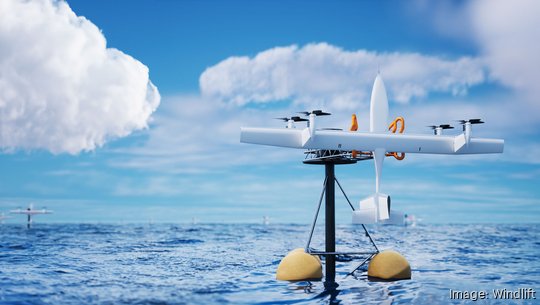
A Durham company focused on harvesting wind energy using drones has swelled its staff size in recent months.
By securing a $30 million deal with the Naval Research Lab in September, renewable energy manufacturer Windlift has more than doubled its headcount. This comes after the company encountered a funding gap last year.
Vice President of Business Development Ben Leape shared some of the latest developments at Windlift with Triangle Business Journal as the company aims to launch its tech at scale in 2030. The company, whose headcount was 12 employees last May, is now operating with a team of 29.
This September, the company will be halfway through the first $11.4 million task order under this contract.
“This will get us towards an operational demonstrator by this time next year,” Leape said. “This basically means a system, kind of in a form factor, that service members in the field can take, use and experiment with.”
The product that gained the attention of the Naval Research Lab is a 25-pound tethered drone that can harvest renewable wind energy by pulling it into the grid or storing it in a battery. These mobile drones take a matter of minutes to set up, making them more efficient than traditional wind turbines. Mobility and convenience have made these drones ideal for military applications and offshore wind harvesting.
According to Leape, the contract with the Naval Research Lab has driven most of the growth on the technical side of Windlift’s operations, including hiring 17 new employees who are mainly engineers and composite manufacturing technicians.
In terms of funding this operation, Windlift was also awarded a Phase 1 Small Business Innovation Research (SBIR) grant from the U.S. Department of Energy’s Wind Energy Technology Office. Leape said these funds will be used to design the floating platform that will allow Windlift’s technology to be employed offshore.
While Windlift did not disclose the exact amount it received from the DOE, SBIR Phase 1 grants are usually $50,000 to $250,000 for six months to one year.
Triangle Business Journal previously reported that Windlift had been awarded $24 million in government contracts. In addition to the DOE grant, Windlift has raised a few hundred thousand dollars in equity financing.
Later this summer, Windlift plans to fundraise through venture capital. The initiative has not yet begun, but Leape said they will be reaching out to aligned investors soon.
“We aim to raise the private capital necessary to integrate our defense work and our DOE work to pursue the offshore wind market,” Leape said.
These advancements at Windlift come after it encountered a one-year funding gap last year “due to the nature of the defense industry.” Leape referred to Windlift’s funding gap as a result of the “notorious valley of death that exists in defense contracting.”
“But one of the things to come out of this is our penetration into the offshore wind market,” Leape said. “And winning our partnership with the Department of Energy to pursue that use for our technology.”
Looking to the future, Windlift plans to dual track in defense and mobile power and offshore wind. Given its 5-year contract on the defense side, Leape said the company wants to steadily progress toward the final product for procurement over the next couple of years.
“And on the offshore side of things,” Leape said. “We have a couple partnerships in the state with the Coastal Studies Institute’s Cape Fear Ocean Labs and the Atlantic Marine Energy Center to move forward with a mix of DOE and private funding towards the offshore wind opportunity.”
While currently stationed at 2445 S. Alston Avenue in Durham, Windlift is exploring potential locations to establish a footprint on the coast.
“A lot of that will depend on the progress of the offshore wind industry in the state,” Leape said. “But we are very much North Carolina-focused, and we think we can do the whole thing here.”
